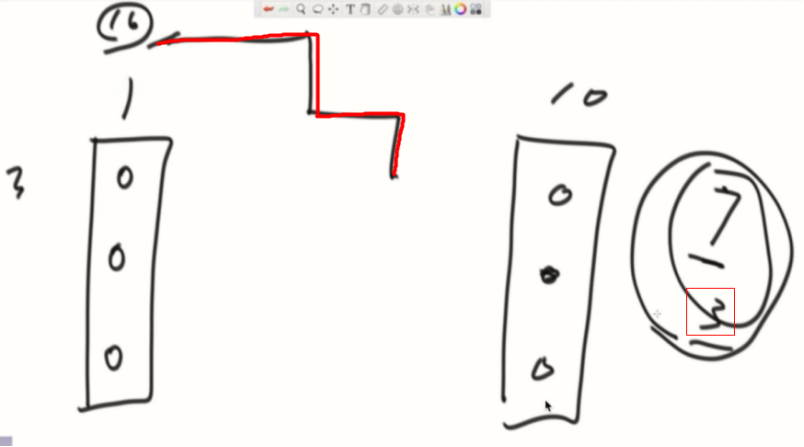接着第四课的内容,主要讲LFU、表达式计算和跳表
第一题
上一题实现了LRU缓存算法,LFU也是一个著名的缓存算法
自行了解之后实现LFU中的set 和 get
要求:两个方法的时间复杂度都为O(1)
LFU根据get、set操作次数决定的优先级。
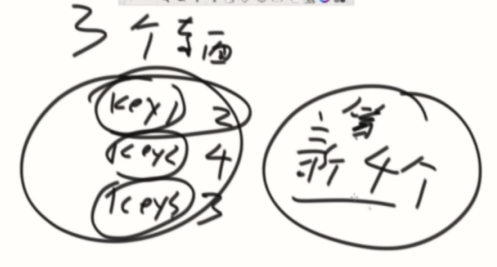
同样次数,最不经常访问的先出去。
实现思路:建立一个次数链,每个次数再链接上一个双向链。(两个双链表)

Put和Get的时候,先检查是否存在
如果没有,put就存在1的链表下,get就返回null。
如果有,找到属于哪个头,然后分离出来,查看头部的下一个是否次数+1的关系,有就插入,没有就建出来。每次挂都是挂在小链表的头部。
size满了,就删最左边底下的head。
看代码...(代码是把最近操作的放在头部)
public class Code_03_LFU { //小链表的节点 public static class Node { public Integer key; public Integer value; public Integer times; public Node up; public Node down; public Node(int key, int value, int times) { this.key = key; this.value = value; this.times = times; } } public static class LFUCache { //把次数相同的节点连在一起的链表 public static class NodeList { //本链的头尾 public Node head; public Node tail; //前一个和后一个 public NodeList last; public NodeList next; public NodeList(Node node) { head = node; tail = node; } public void addNodeFromHead(Node newHead) { newHead.down = head; head.up = newHead; head = newHead; } public boolean isEmpty() { return head == null; } //其中的任何节点都可能删,因为次数增加也要调整节点位置 //把节点从本环境中分离 public void deleteNode(Node node) { if (head == tail) { head = null; tail = null; } else { if (node == head) {//头 head = node.down; head.up = null; } else if (node == tail) {//尾 tail = node.up; tail.down = null; } else {//其中 node.up.down = node.down; node.down.up = node.up; } } node.up = null; node.down = null; } } private int capacity;//容量 private int size;//当前大小 //通过key找Node private HashMap<Integer, Node> records; //找到Node的当前所在链表 private HashMap<Node, NodeList> heads; private NodeList headList; public LFUCache(int capacity) { this.capacity = capacity; this.size = 0; this.records = new HashMap<>(); this.heads = new HashMap<>(); headList = null; } public void set(int key, int value) { if (records.containsKey(key)) {//存在 Node node = records.get(key); node.value = value; node.times++; NodeList curNodeList = heads.get(node); move(node, curNodeList);//帮node找新家 } else { if (size == capacity) {//腾出空间 Node node = headList.tail; headList.deleteNode(node); modifyHeadList(headList);//检查是否要调整(有可能删光了) records.remove(node.key); heads.remove(node); size--; } Node node = new Node(key, value, 1); if (headList == null) {//第一次加 headList = new NodeList(node); } else { //检查是否存在专属的次数链表 if (headList.head.times.equals(node.times)) { headList.addNodeFromHead(node); } else {//没有就建 NodeList newList = new NodeList(node); newList.next = headList; headList.last = newList; headList = newList; } } //记录信息 records.put(key, node); heads.put(node, headList); size++; } } private void move(Node node, NodeList oldNodeList) { oldNodeList.deleteNode(node);//先从老家搬出 //搬出后老家有可能因为无住户而被拆除,所以前指向要判断下 NodeList preList = modifyHeadList(oldNodeList) ? oldNodeList.last : oldNodeList; NodeList nextList = oldNodeList.next; if (nextList == null) {//新家不存在,建一个 NodeList newList = new NodeList(node); if (preList != null) {//老家还在 preList.next = newList; } newList.last = preList; //应对1---3的情况,删了1,后面没2,自然新建的2会变为新头 // ^a---^b if (headList == null) { headList = newList; } heads.put(node, newList);//加入记录 } else { //新家合适,是老家+1的配套 if (nextList.head.times.equals(node.times)) { nextList.addNodeFromHead(node); heads.put(node, nextList); } else {//新家不合适,建一个 NodeList newList = new NodeList(node); if (preList != null) {//保证前一个节点不为空,不然下面代码报错 preList.next = newList; } newList.last = preList; newList.next = nextList; nextList.last = newList; if (headList == nextList) {//判断头链表是否有变化 headList = newList; } heads.put(node, newList);//加入记录 } } } // return whether delete this head private boolean modifyHeadList(NodeList nodeList) { if (nodeList.isEmpty()) {//如果房子没有住户,要进行拆除 if (headList == nodeList) {//如果是头节点 headList = nodeList.next; if (headList != null) {//尾部的情况 headList.last = null; } } else {//普通节点 nodeList.last.next = nodeList.next; if (nodeList.next != null) {//尾部的话就是null的 nodeList.next.last = nodeList.last; } } return true; } return false; } public int get(int key) { if (!records.containsKey(key)) { return -1; } Node node = records.get(key); node.times++; NodeList curNodeList = heads.get(node); move(node, curNodeList);//帮Node找新家 return node.value; } } }
打完这代码,其他什么链表操作都是你孙子。
等同于面对真正对手前,练的打木桩和铁砂掌。
面试经验:
面试官问如果测试代码你会怎么测?
要把对数器的思路说上。
考察你是否想到一些极端的边界情况。
解决方法:
在写代码的过程中,出错点、代码边界点、需要讨论的东西,记下来,养成一种思维习惯。
写代码的时候,遇到特殊情况,纸笔记录下来,面试官问的时候,你都已经记录好了。
题目二:
给定一个字符串str,str表示一个公式,公式里可能有整数、加减乘除符号和左右括号,返回公式的计算结果。
【举例】
str="48*((70-65)-43)+8*1",返回-1816。
str="3+1*4",返回7。 str="3+(1*4)",返回7。
【说明】
1.可以认为给定的字符串一定是正确的公式,即不需要对str做公式有效性检查。
2.如果是负数,就需要用括号括起来,比如"4*(-3)"。但如果负数作为公式的开头或括号部分的开头,则可以没有括号,比如"-3*4"和"(-3)*4"都是合法的。
3.不用考虑计算过程中会发生溢出的情况
需要好的代码结构设计
思路:
分没有小括号和有小括号的计算方法。
没有小括号的情况:不是 * / 直接往里放,是就取出一个计算后再放回去。
最后全部放完只剩下加减运算。

相当于乘除所在区域合成一块。
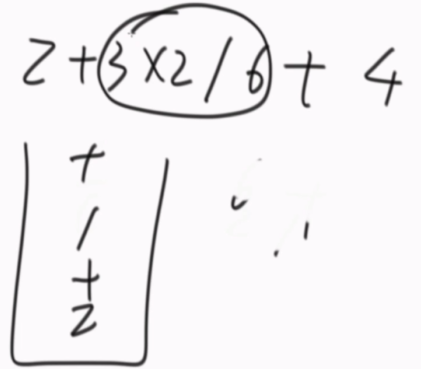
有小括号的情况:
定义一个函数。
str从index开始计算公式,遇到)或str结尾,过程结束。
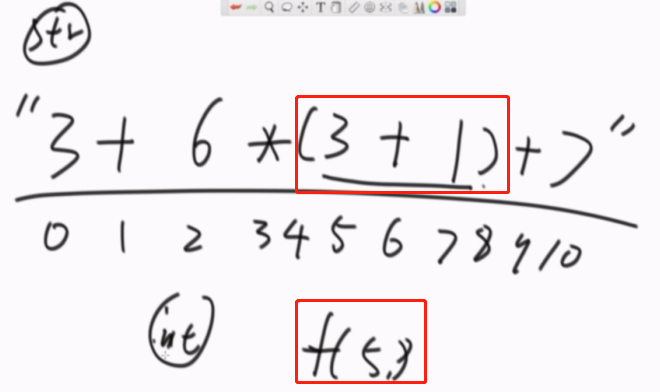
遇到左括号后,后面的东西就不算了,直接扔给调子过程,碰到右括号再返回[结果和算到哪个位置]。
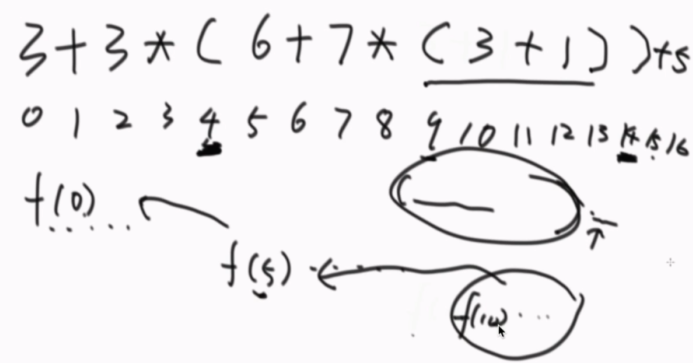
看到code
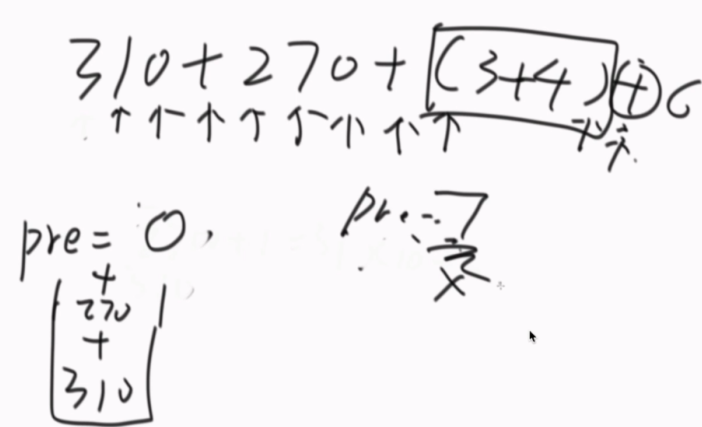
public class Code_07_ExpressionCompute { public static int getValue(String str) { return value(str.toCharArray(), 0)[0]; } //返回数组[计算结果,计算到哪个位置] public static int[] value(char[] str, int i) { //双端队列 LinkedList<String> que = new LinkedList<String>(); int pre = 0;//收集数字 int[] bra = null; while (i < str.length && str[i] != ')') { if (str[i] >= '0' && str[i] <= '9') {//把数字重组,注意有= pre = pre * 10 + str[i++] - '0'; } else if (str[i] != '(') {// + - * / //收集数字和符号,数字+符号是一组 addNum(que, pre); que.addLast(String.valueOf(str[i++])); pre = 0;//注意清0 } else {// 当前i位置为( bra = value(str, i + 1);//不管,直接递归 pre = bra[0]; i = bra[1] + 1; } } addNum(que, pre); return new int[] { getNum(que), i }; } public static void addNum(LinkedList<String> que, int num) { if (!que.isEmpty()) { int cur = 0; String top = que.pollLast(); if (top.equals("+") || top.equals("-")) { que.addLast(top);//放回去 } else { cur = Integer.valueOf(que.pollLast()); num = top.equals("*") ? (cur * num) : (cur / num); } } que.addLast(String.valueOf(num)); } //计算加减 public static int getNum(LinkedList<String> que) { int res = 0; boolean add = true; String cur = null; int num = 0; while (!que.isEmpty()) { cur = que.pollFirst(); if (cur.equals("+")) { add = true; } else if (cur.equals("-")) { add = false; } else { num = Integer.valueOf(cur); res += add ? num : (-num); } } return res; } public static void main(String[] args) { String exp = "48*((70-65)-43)+8*1"; System.out.println(getValue(exp)); exp = "4*(6+78)+53-9/2+45*8"; System.out.println(getValue(exp)); exp = "10-5*3"; System.out.println(getValue(exp)); exp = "-3*4"; System.out.println(getValue(exp)); exp = "3+1*4"; System.out.println(getValue(exp)); } }
判断一棵二叉树是否是搜索二叉树
判断一棵二叉树是否是完全二叉树(基础班讲过)
按层遍历(队列)节点,
1、如果当前节点有右无左直接false
2、不违反1的情况,当前节点左右不全,剩下的全都要叶子节点。
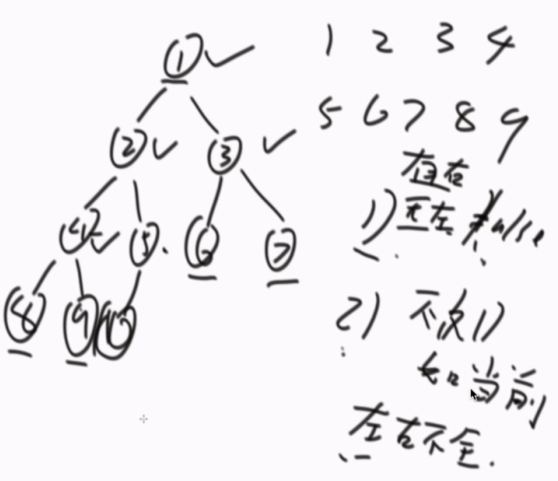

public class Code_07_IsBSTAndCBT { public static class Node { public int value; public Node left; public Node right; public Node(int data) { this.value = data; } } //Morris遍历 //左子树小、右子树大 public static boolean isBST(Node head) { if (head == null) { return true; } boolean res = true; Node pre = null; Node cur1 = head; Node cur2 = null; while (cur1 != null) { cur2 = cur1.left; if (cur2 != null) { while (cur2.right != null && cur2.right != cur1) { cur2 = cur2.right; } if (cur2.right == null) { cur2.right = cur1; cur1 = cur1.left; continue; } else { cur2.right = null; } } if (pre != null && pre.value > cur1.value) { res = false; } pre = cur1; cur1 = cur1.right; } return res; } public static boolean isCBT(Node head) { if (head == null) { return true; } Queue<Node> queue = new LinkedList<Node>(); boolean leaf = false; Node l = null; Node r = null; queue.offer(head); while (!queue.isEmpty()) { head = queue.poll(); l = head.left; r = head.right; if ((leaf && (l != null || r != null)) || (l == null && r != null)) { return false; } if (l != null) { queue.offer(l); } if (r != null) { queue.offer(r); } else {//如果右子树为空,左子树不为空,接下来的都要是叶子节点 leaf = true; } } return true; } // for test -- print tree public static void printTree(Node head) { System.out.println("Binary Tree:"); printInOrder(head, 0, "H", 17); System.out.println(); } public static void printInOrder(Node head, int height, String to, int len) { if (head == null) { return; } printInOrder(head.right, height + 1, "v", len); String val = to + head.value + to; int lenM = val.length(); int lenL = (len - lenM) / 2; int lenR = len - lenM - lenL; val = getSpace(lenL) + val + getSpace(lenR); System.out.println(getSpace(height * len) + val); printInOrder(head.left, height + 1, "^", len); } public static String getSpace(int num) { String space = " "; StringBuffer buf = new StringBuffer(""); for (int i = 0; i < num; i++) { buf.append(space); } return buf.toString(); } public static void main(String[] args) { Node head = new Node(4); head.left = new Node(2); head.right = new Node(6); head.left.left = new Node(1); head.left.right = new Node(3); head.right.left = new Node(5); printTree(head); System.out.println(isBST(head)); System.out.println(isCBT(head)); } }
题目三:
回到第三课,讲跳表。
何为跳表?
完成功能(最大的k,比k小/大离他最近的key)和红色树、平衡搜索二叉树一样
代价也是longn,底层结构不是树结构。
Redis按序组织就是跳表结构。
每个数进去前,先random,0/1,直到1,就知道这个数是多少层。
如果L层没到最大层,从最高层开始找,如果最高的下一个大,往下走。如果小往右走。走到不能再走,往下走。
这个过程中,如果到了L层,在往下走之前,先把属于那个层的点先建上,然后往下走。依次建出属于新值的所有层的点。
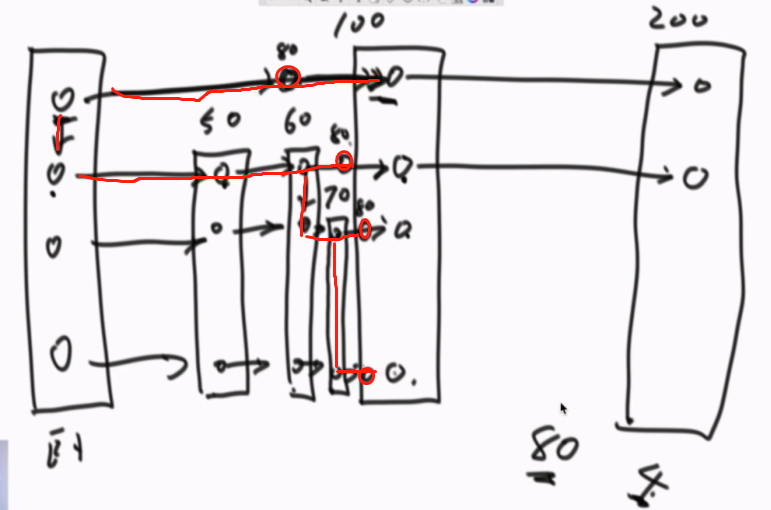
如果数据为N,第一层很多点,但是逐层上去会越来越少,在查询和建立的过程中,是从高层开始找的,一跨会跨过非常多的数。
用1/2概率这东西来优化效率。
从最高层开始找这个数(例如50万)该待的位置,只向下和向右那就跨过很多数了,每层都会跨过一定量的数(因为每个数的层数是1/2随机的),每层一次越过的位置,其实在底层看已经越过相当多的位置了,所以管他叫“跳表”。
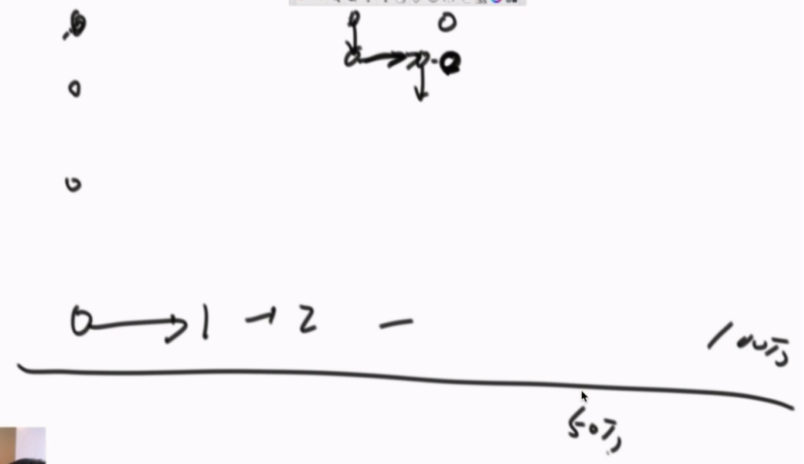
怎么插入,就怎么查。
public class Code_02_SkipList { public static class SkipListNode { public Integer value; //长度为10,说明有10层,nextNodes[1]代表在1层上他的下一个节点是什么 //0层指向null,1指向第一层他的下一个结点是谁,以此类推 //从高层到下 public ArrayList<SkipListNode> nextNodes; public SkipListNode(Integer value) { this.value = value; nextNodes = new ArrayList<SkipListNode>(); } } public static class SkipListIterator implements Iterator<Integer> { SkipList list; SkipListNode current; public SkipListIterator(SkipList list) { this.list = list; this.current = list.getHead(); } public boolean hasNext() { return current.nextNodes.get(0) != null; } public Integer next() { current = current.nextNodes.get(0); return current.value; } } public static class SkipList { private SkipListNode head;//巨小,层数是最高的 private int maxLevel; private int size;//加进来了多少个key private static final double PROBABILITY = 0.5; public SkipList() { size = 0; maxLevel = 0; head = new SkipListNode(null); head.nextNodes.add(null); } public SkipListNode getHead() { return head; } public void add(Integer newValue) { if (!contains(newValue)) { size++; int level = 0; while (Math.random() < PROBABILITY) { level++; } while (level > maxLevel) { head.nextNodes.add(null);//头增加区域到最大层数 maxLevel++; } SkipListNode newNode = new SkipListNode(newValue); SkipListNode current = head;//从头部往下移动 int levelAll = maxLevel;//从最高层开始找 do { current = findNext(newValue, current, levelAll); if (levelAll <= level){//达到应该加入节点的层 //前后环境接上 //当前层,建立指向刚好比自己大的节点的联系 //例如一共5层,由于是从高层开始插入,先把第五层加入0位置 //接着第四层的时候也是加到0位置,那就把原本第五层的挤到1位置 //...以此类推,加到最后一层就会是正常的0位置 // 最后一层也已经被挤到最后的位置上 newNode.nextNodes.add(0, current.nextNodes.get(level)); //把刚好比他小的节点,指向他。例如:7--->10 加入8 变成7--->8--->10 current.nextNodes.set(level, newNode); level--; } } while (levelAll-- > 0);//当前层小了往右,大了往下 } } public void delete(Integer deleteValue) { if (contains(deleteValue)) { SkipListNode deleteNode = find(deleteValue); size--; int level = maxLevel; SkipListNode current = head; do { current = findNext(deleteNode.value, current, level); if (deleteNode.nextNodes.size() > level) { current.nextNodes.set(level, deleteNode.nextNodes.get(level)); } } while (level-- > 0); } } // Returns the skiplist node with greatest value <= e private SkipListNode find(Integer e) { return find(e, head, maxLevel); } // Returns the skiplist node with greatest value <= e // Starts at node start and level private SkipListNode find(Integer e, SkipListNode current, int level) { do { current = findNext(e, current, level); } while (level-- > 0); return current; } // Returns the node at a given level with highest value less than e private SkipListNode findNext(Integer e, SkipListNode current, int level) { //获得当前节点所在层中连接的下一个节点(例如cur在第七层中的下一个) SkipListNode next = current.nextNodes.get(level); while (next != null) { Integer value = next.value; if (lessThan(e, value)) { // e < value break;//如果下一个数比新增值大了,就找到接入位置。 //cur就是这一层中,最后一个小于当前数的值。 } //向右动 current = next; next = current.nextNodes.get(level); } return current; } public int size() { return size; } public boolean contains(Integer value) { SkipListNode node = find(value); return node != null && node.value != null && equalTo(node.value, value); } public Iterator<Integer> iterator() { return new SkipListIterator(this); } /****************************************************************************** * Utility Functions * ******************************************************************************/ private boolean lessThan(Integer a, Integer b) { return a.compareTo(b) < 0; } private boolean equalTo(Integer a, Integer b) { return a.compareTo(b) == 0; } } public static void main(String[] args) { } }
add操作图解
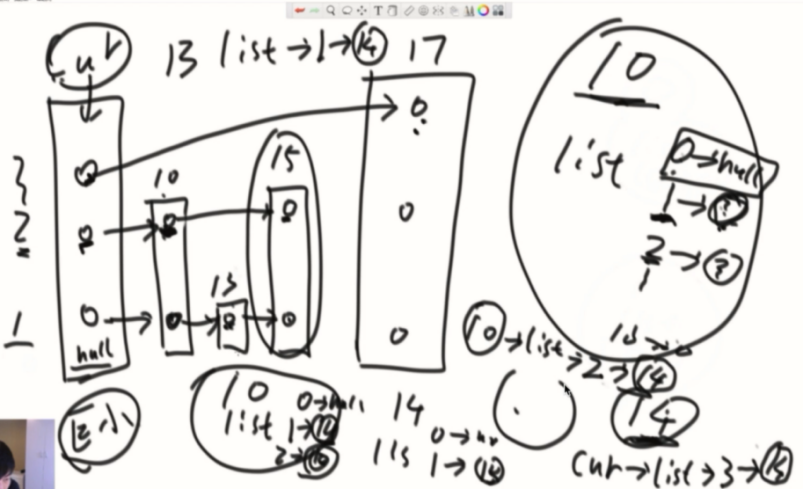
证明算法复杂度:
可以研究下他的分布,不管输入规律是什么,基本上就是一颗二叉树的样子,概率是0.5,那下一层基本是本层数量的两倍,所以是logn的代价,一跳,跳过很多节点,一共跳多少层就是代价,逻辑概念可以等同于一颗二叉树,但是他是以概率完成的。
add方法存在问题,应该是从最高层开始找的,现在是从random出来的level开始找。应该是从最高层向下向右找到相应的位置,达到level层后再开始加入。(例如random出了第一层,如果从第一层开始遍历,就不是longn的算法了)(上面展示的代码已经修正)
